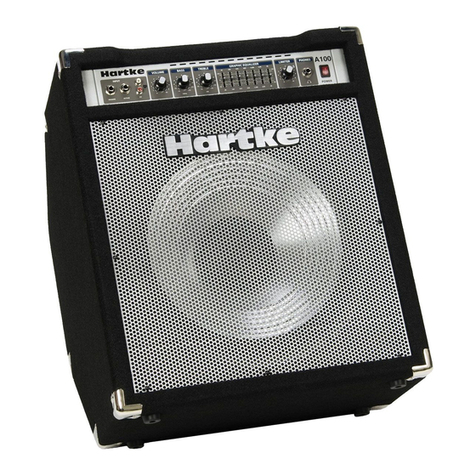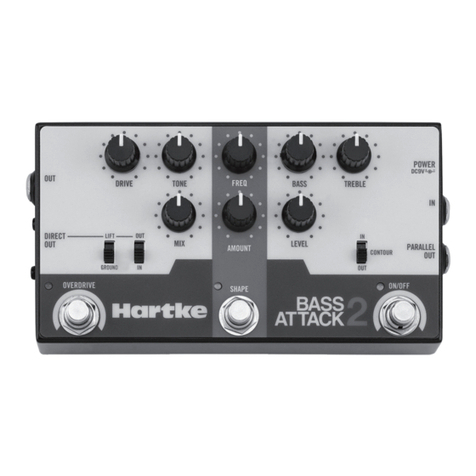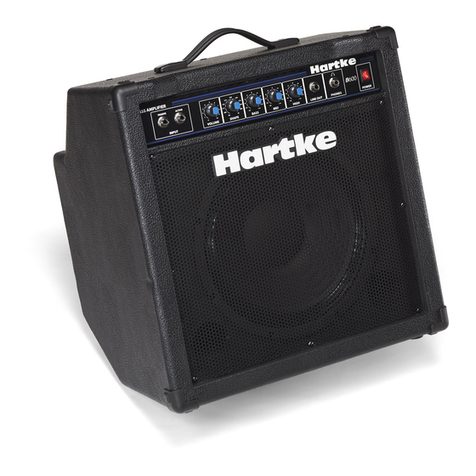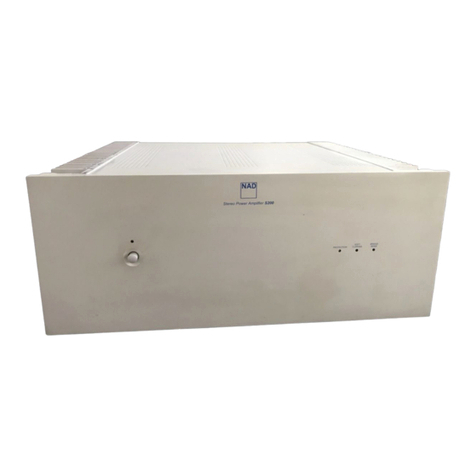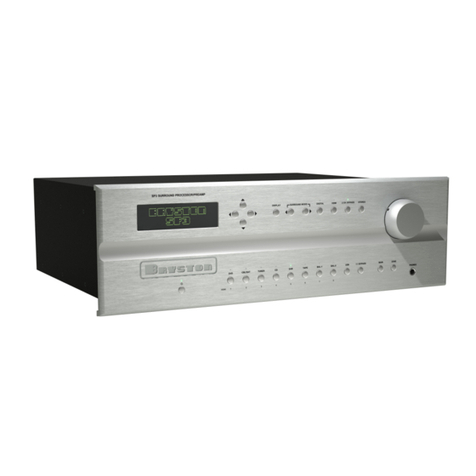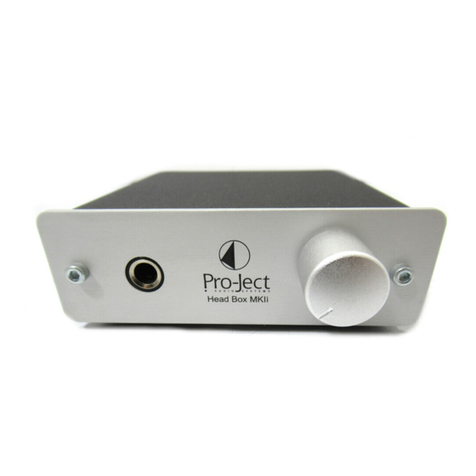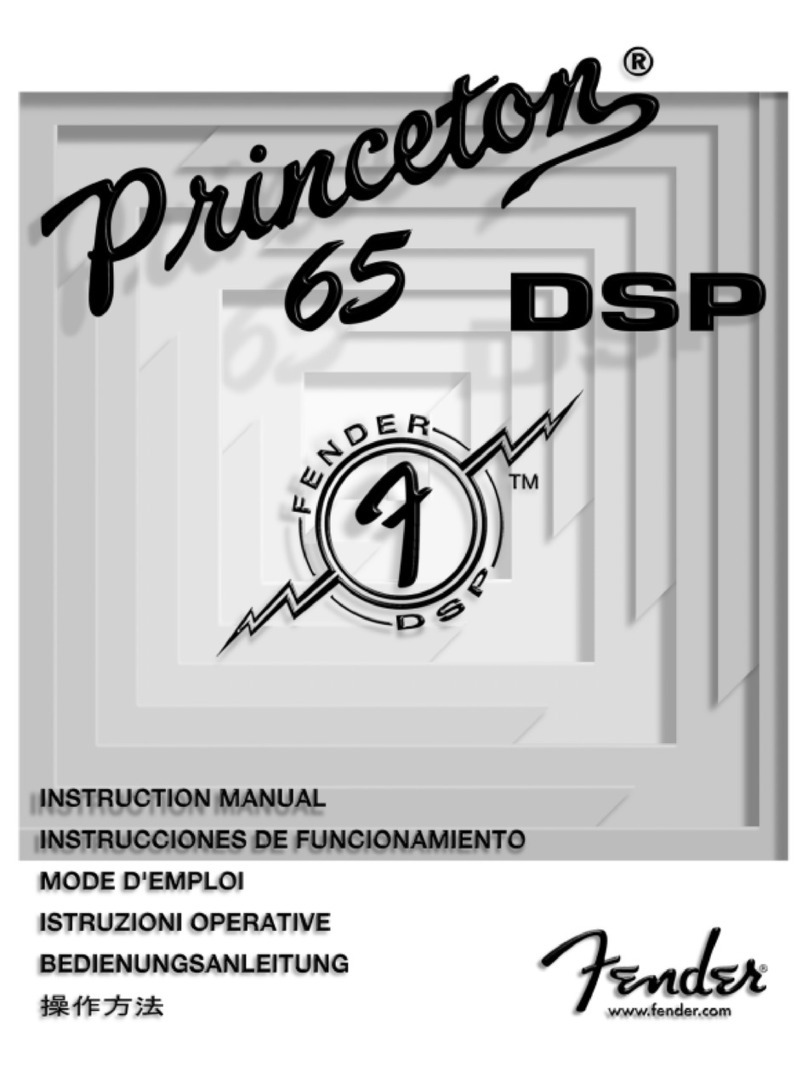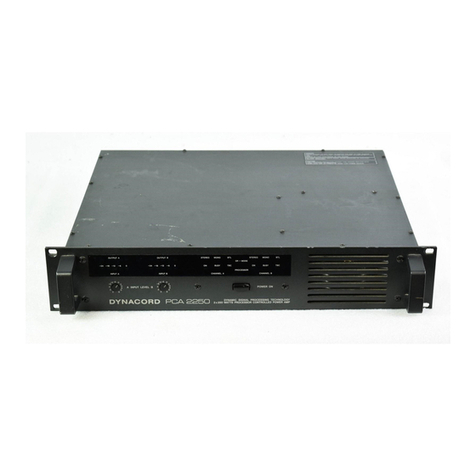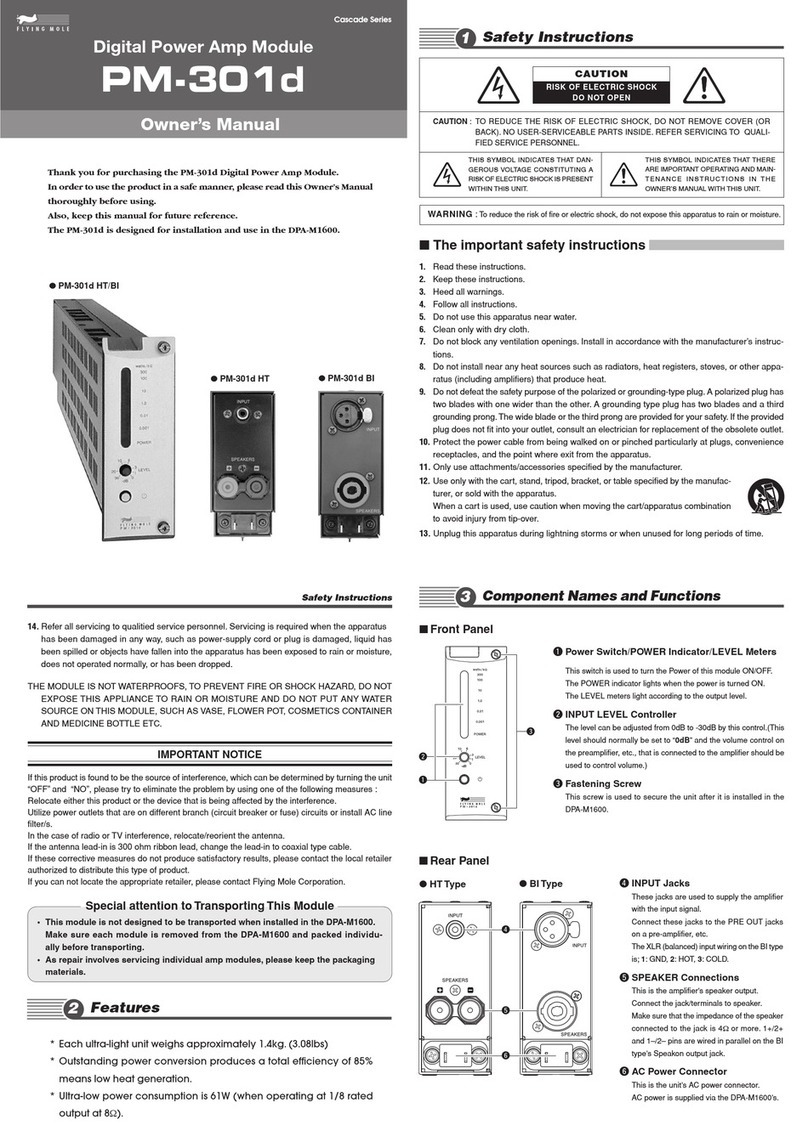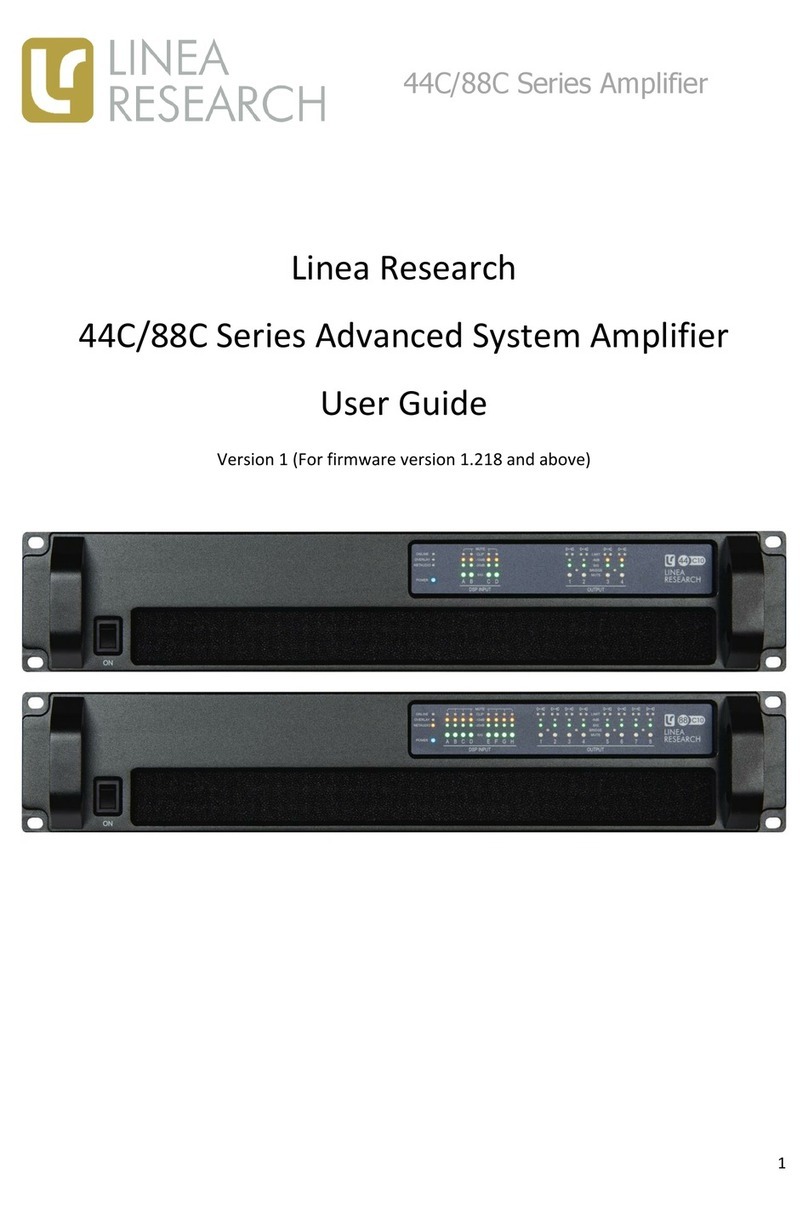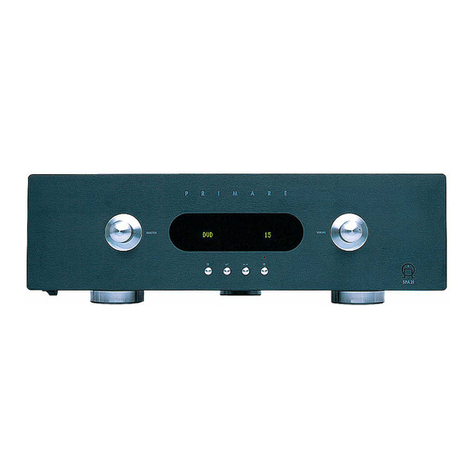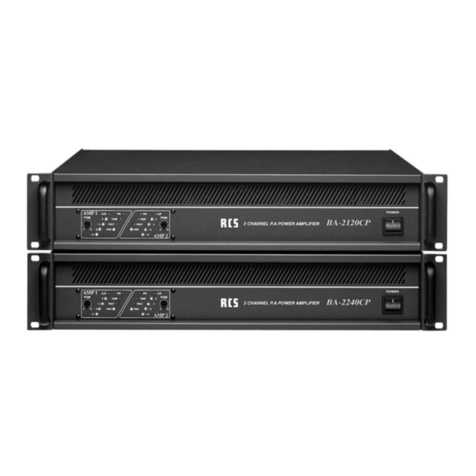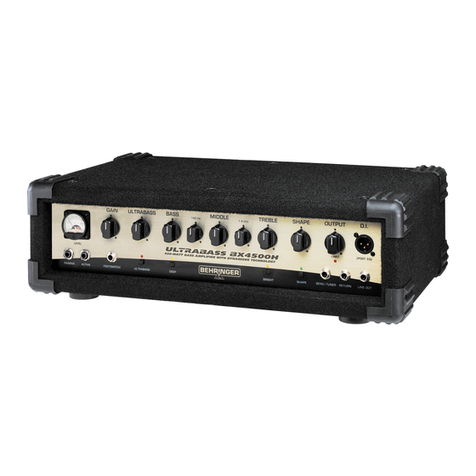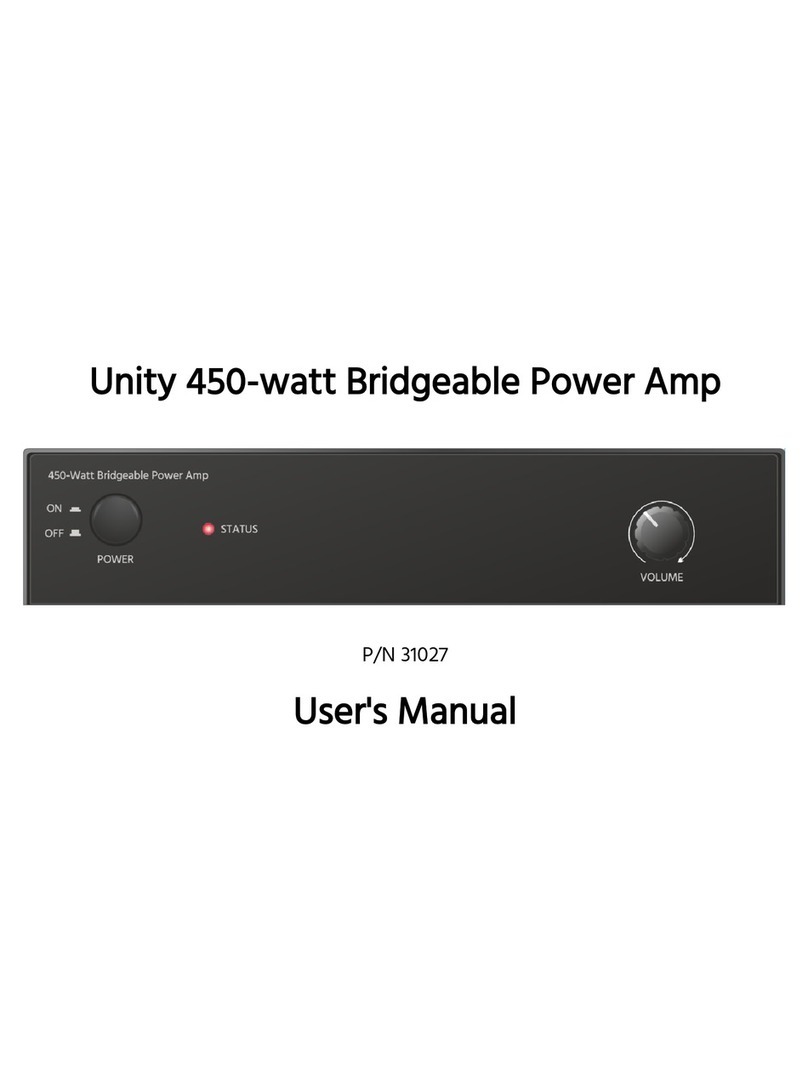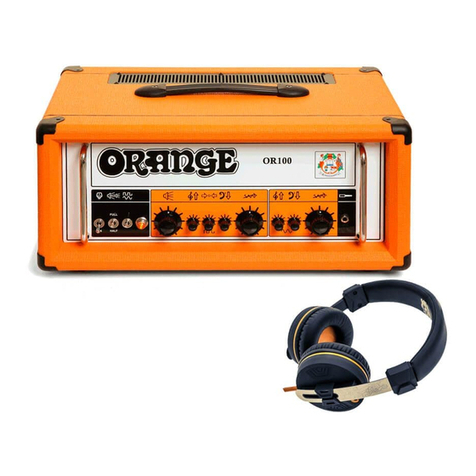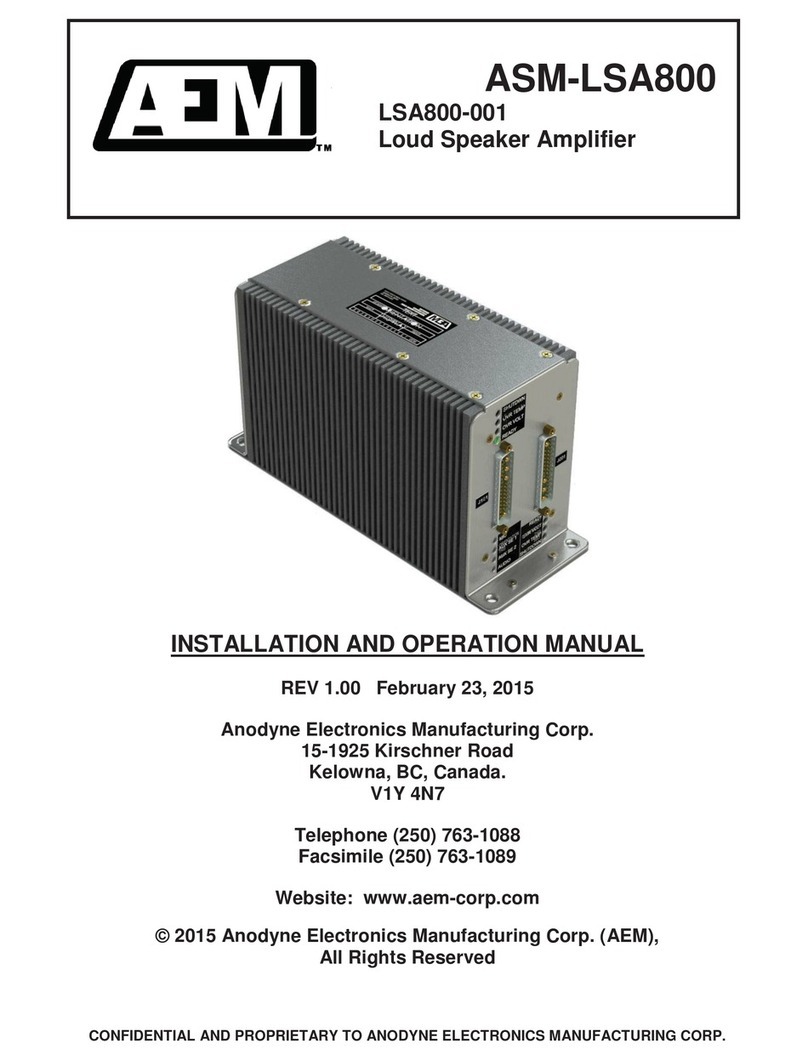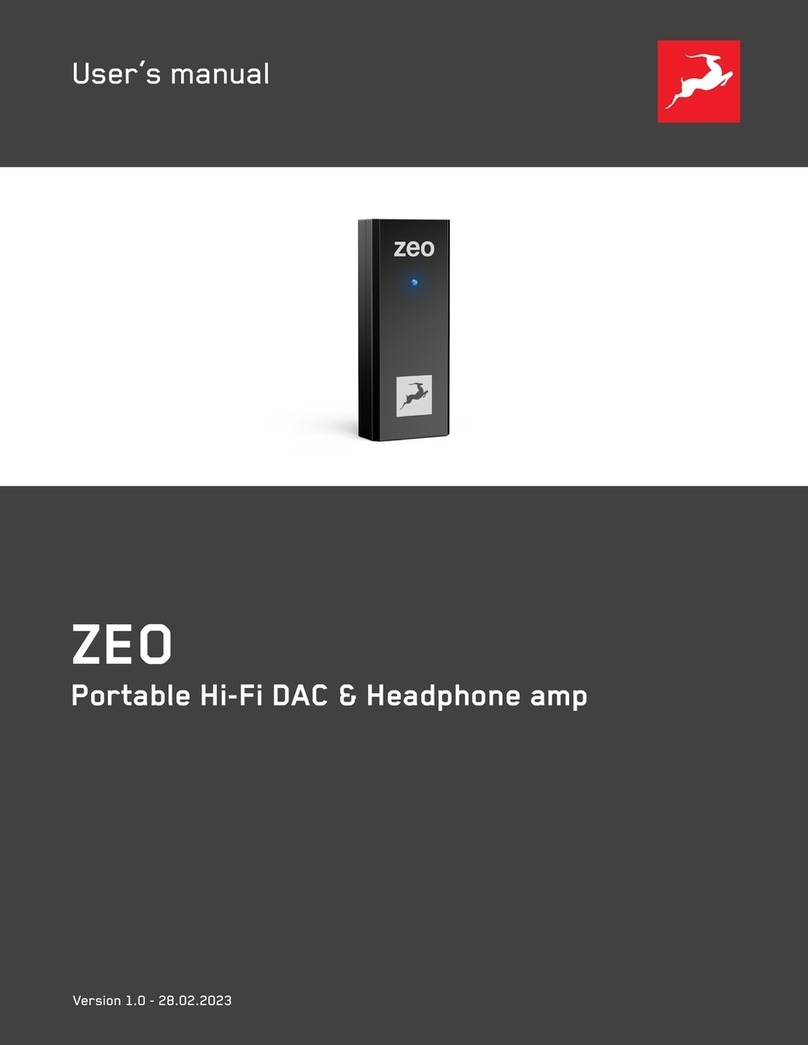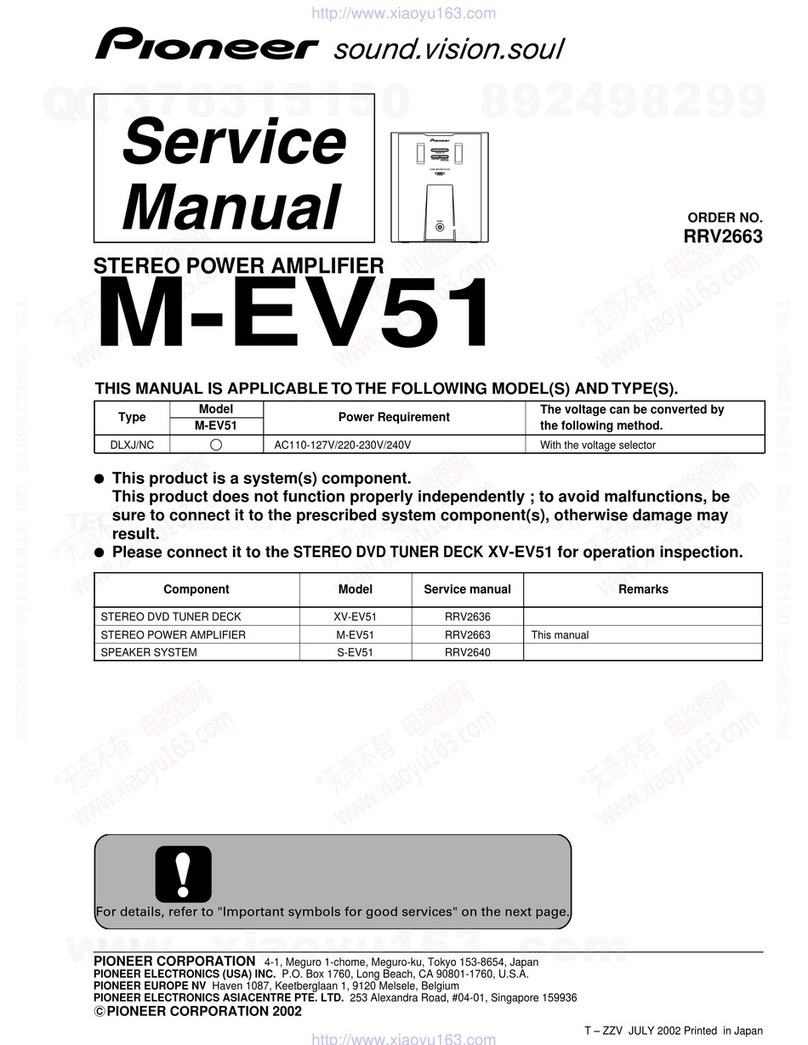Hartke AC75 User manual

Acoustic Instrument Amplifi er

Important Safety Instructions
1. Please read all instructions before operating the unit.
2. Keep these instructions for future reference.
3. Please heed all safety warnings.
4. Follow manufacturers instructions.
5. Do not use this unit near water or moisture.
6. Clean only with a damp cloth.
7. Do not block any of the ventilation openings. Install in accordance with the manufacturers instructions.
8. Do not install near any heat sources such as radiators, heat registers, stoves, or other apparatus (includ-
ing amplifiers) that produce heat.
9. Do not defeat the safety purpose of the polarized or grounding-type plug. A polarized plug has two
blades with one wider than the other. A grounding type plug has two blades and a third grounding
prong. The wide blade or third prong is provided for your safety. When the provided plug does not fit
your outlet, consult an electrician for replacement of the obsolete outlet.
10. Protect the power cord from being walked on and pinched particularly at plugs, convenience recep-
tacles and at the point at which they exit from the unit.
11. Unplug this unit during lightning storms or when unused for long periods of time.
12. Refer all servicing to qualified personnel. Servicing is required when the unit has been damaged in
any way, such as power supply cord or plug damage, or if liquid has been spilled or objects have fallen
into the unit, the unit has been exposed to rain or moisture, does not operate normally, or has been
dropped.
WARNING: To reduce the risk of fire or electric shock, do not expose this unit to rain or moisture.
The lightning flash with an arrowhead symbol within an equilateral triangle, is intended to alert the user to the
presence of un-insulated "dangerous voltage" within the products enclosure that may be of sufficient magni-
tude to constitute a risk of electric shock to persons.
The exclamation point within an equilateral triangle is intended to alert the user to the presence of important
operating and maintenance (servicing) instructions in the literature accompanying the product.
Caution: To reduce the hazard of electrical shock, do
not remove cover or back.
No user serviceable parts inside. Please refer all servic-
ing to qualified personnel.

ATTENTION: Pour éviter tout risque d’électrocution ou d’incendie, ne pas exposer cet appareil à la pluie ou
à l’humidité. Pour éviter tout risque d’électrocution, ne pas ôter le couvercle ou le dos du boîtier. Cet appareil ne
contient aucune pièce remplaçable par l'utilisateur. Confiez toutes les réparations à un personnel qualifié. Le
signe avec un éclair dans un triangle prévient l’utilisateur de la présence d’une tension dangereuse et non
isolée dans l’appareil. Cette tension constitue un risque d’électrocution. Le signe avec un point d’exclamation
dans un triangle prévient l’utilisateur d’instructions importantes relatives à l’utilisation et à la maintenance du
produit.
Consignes de sécurité importantes
1. Veuillez lire toutes les instructions avant d’utiliser l’appareil.
2. Conserver ces instructions pour toute lecture ultérieure.
3. Lisez avec attention toutes les consignes de sécurité.
4. Suivez les instructions du fabricant.
5. Ne pas utiliser cet appareil près d’une source liquide ou dans un lieu humide.
6. Nettoyez l’appareil uniquement avec un tissu humide.
7. Veillez à ne pas obstruer les fentes prévues pour la ventilation de l’appareil. Installez l’appareil selon les
instructions du fabricant.
8. Ne pas installer près d’une source de chaleur (radiateurs, etc.) ou de tout équipement susceptible de
générer de la chaleur (amplificateurs de puissance par exemple).
9. Ne pas retirer la terre du cordon secteur ou de la prise murale. Les fiches canadiennes avec polarisation
(avec une lame plus large) ne doivent pas être modifiées. Si votre prise murale ne correspond pas au
modèle fourni, consultez votre électricien.
10. Protégez le cordon secteur contre tous les dommages possibles (pincement, tension, torsion,, etc.).
Veillez à ce que le cordon secteur soit libre, en particulier à sa sortie du boîtier.
11. Déconnectez l’appareil du secteur en présence d’orage ou lors de périodes d’inutilisation prolongées.
12. Consultez un service de réparation qualifié pour tout dysfonctionnement (dommage sur le cordon
secteur, baisse de performances, exposition à la pluie, projection liquide dans l’appareil, introduction
d’un objet dans le boîtier, etc.).
ACHTUNG: Um die Gefahr eines Brandes oder Stromschlags zu verringern, sollten Sie dieses Gerät weder
Regen noch Feuchtigkeit aussetzen.Um die Gefahr eines Stromschlags zu verringern, sollten Sie weder
Deckel noch Rückwand des Geräts entfernen. Im Innern befinden sich keine Teile, die vom Anwender gewar-
tet werden können. Überlassen Sie die Wartung qualifiziertem Fachpersonal.Der Blitz mit Pfeilspitze im glei-
chseitigen Dreieck soll den Anwender vor nichtisolierter “gefährlicher Spannung” im Geräteinnern warnen.
Diese Spannung kann so hoch sein, dass die Gefahr eines Stromschlags besteht. Das Ausrufezeichen im
gleichseitigen Dreieck soll den Anwender auf wichtige Bedienungs- und Wartungsanleitungen aufmerksam
machen, die im mitgelieferten Informationsmaterial näher beschrieben werden.
Wichtige Sicherheitsvorkehrungen
1. Lesen Sie alle Anleitungen, bevor Sie das Gerät in Betrieb nehmen.
2. Bewahren Sie diese Anleitungen für den späteren Gebrauch gut auf.
3. Bitte treffen Sie alle beschriebenen Sicherheitsvorkehrungen.
4. Befolgen Sie die Anleitungen des Herstellers.
5. Benutzen Sie das Gerät nicht in der Nähe von Wasser oder Feuchtigkeit.
6. Verwenden Sie zur Reinigung des Geräts nur ein feuchtes Tuch.
7. Blockieren Sie keine Belüftungsöffnungen. Nehmen Sie den Einbau des Geräts nur entsprechend den
Anweisungen des Herstellers vor.
8. Bauen Sie das Gerät nicht in der Nähe von Wärmequellen wie Heizkörpern, Wärmeklappen, Öfen oder
anderen Geräten (inklusive Verstärkern) ein, die Hitze erzeugen.
9. Setzen Sie die Sicherheitsfunktion des polarisierten oder geerdeten Steckers nicht außer Kraft. Ein
polarisierter Stecker hat zwei flache, unterschiedlich breite Pole. Ein geerdeter Stecker hat zwei flache
Pole und einen dritten Erdungsstift. Der breitere Pol oder der dritte Stift dient Ihrer Sicherheit. Wenn der
vorhandene Stecker nicht in Ihre Steckdose passt, lassen Sie die veraltete Steckdose von einem Elektriker
ersetzen.
10. Schützen Sie das Netzkabel dahingehend, dass niemand darüber laufen und es nicht geknickt werden
kann. Achten Sie hierbei besonders auf Netzstecker, Mehrfachsteckdosen und den Kabelanschluss am
Gerät.
11. Ziehen Sie den Netzstecker des Geräts bei Gewittern oder längeren Betriebspausen aus der Steckdose.
12. Überlassen Sie die Wartung qualifiziertem Fachpersonal. Eine Wartung ist notwendig, wenn das Gerät auf
irgendeine Weise, beispielsweise am Kabel oder Netzstecker beschädigt wurde, oder wenn Flüssigkeiten
oder Objekte in das Gerät gelangt sind, es Regen oder Feuchtigkeit ausgesetzt war, nicht mehr wie
gewohnt betrieben werden kann oder fallen gelassen wurde.

Copyright 2003 Samson Technologies Corp.
Printed January, 2003 - 2006 v 5.0
www.hartke.com
Phone: 1-800-3-SAMSON (1-800-372-6766)
Fax: 516-364-3888
PRECAUCION: Para reducir el riesgo de incendios o descargas, no permita que este aparato quede expuesto
a la lluvia o la humedad. Para reducir el riesgo de descarga eléctrica, nunca quite la tapa ni el chasis. Dentro
del aparato no hay piezas susceptibles de ser reparadas por el usuario. Dirija cualquier reparación al servicio
técnico oficial. El símbolo del relámpago dentro del triángulo equilátero pretende advertir al usuario de la
presencia de “voltajes peligrosos” no aislados dentro de la carcasa del producto, que pueden ser de la magni-
tud suficiente como para constituir un riesgo de descarga eléctrica a las personas. El símbolo de exclamación
dentro del triángulo equilátero quiere advertirle de la existencia de importantes instrucciones de manejo y
mantenimiento (reparaciones) en los documentos que se adjuntan con este aparato.
Instrucciones importantes de seguridad
1. Lea todo este manual de instrucciones antes de comenzar a usar la unidad.
2. Conserve estas instrucciones para cualquier consulta en el futuro.
3. Cumpla con todo lo indicado en las precauciones de seguridad.
4. Observe y siga todas las instrucciones del fabricante.
5. Nunca utilice este aparato cerca del agua o en lugares húmedos.
6. Limpie este aparato solo con un trapo suave y ligeramente humedecido.
7. No bloquee ninguna de las aberturas de ventilación. Instale este aparato de acuerdo a las instrucciones
del fabricante.
8. No instale este aparato cerca de fuentes de calor como radiadores, calentadores, hornos u otros apara-
tos (incluyendo amplificadores) que produzcan calor.
9. No anule el sistema de seguridad del enchufe de tipo polarizado o con toma de tierra. Un enchufe polar-
izado tiene dos bornes, uno más ancho que el otro. Uno con toma de tierra tiene dos bornes normales y
un tercero para la conexión a tierra. El borne ancho o el tercero se incluyen como medida de seguridad.
Cuando el enchufe no encaje en su salida de corriente, llame a un electricista para que le cambie su
salida anticuada.
10. Evite que el cable de corriente quede en una posición en la que pueda ser pisado o aplastado, especial-
mente en los enchufes, receptáculos y en el punto en el que salen de la unidad.
11. Desconecte de la corriente este aparato durante las tormentas eléctricas o cuando no lo vaya a usar
durante un periodo de tiempo largo.
12. Dirija cualquier posible reparación solo al servicio técnico oficial. Deberá hacer que su aparato sea repa-
rado cuando esté dañado de alguna forma, como si el cable de corriente o el enchufe están dañados, o
si se han derramado líquidos o se ha introducido algún objeto dentro de la unidad, si esta ha quedado
expuesta a la lluvia o la humedad, si no funciona normalmente o si ha caído al suelo.
ATTENZIONE: per ridurre il rischio di incendio o di scariche elettriche, non esponete questo apparecchio
a pioggia o umidità. Per ridurre il pericolo di scariche elettriche evitate di rimuoverne il coperchio o il pan-
nello posteriore. Non esistono all'interno dell'apparecchio parti la cui regolazione è a cura dell'utente. Per
eventuale assistenza, fate riferimento esclusivamente a personale qualificato. Il fulmine con la punta a freccia
all'interno di un triangolo equilatero avvisa l'utente della presenza di "tensioni pericolose" non isolate all'interno
dell'apparecchio, tali da costituire un possibile rischio di scariche elettriche dannose per le persone. Il punto
esclamativo all'interno di un triangolo equilatero avvisa l'utente della presenza di importanti istruzioni di
manutenzione (assistenza) nella documentazione che accompagna il prodotto.
Importanti Istruzioni di Sicurezza
1. Prima di usare l'apparecchio, vi preghiamo di leggerne per intero le istruzioni.
2. Conservate tali istruzioni per una eventuale consultazione futura.
3. Vi preghiamo di rispettare tutte le istruzioni di sicurezza.
4. Seguite tutte le istruzioni del costruttore.
5. Non usate questo apparecchio vicino ad acqua o umidità.
6. Pulite l'apparecchio esclusivamente con un panno asciutto.
7. Evitate di ostruire una qualsiasi delle aperture di ventilazione. Posizionatelo seguendo le istruzioni del
costruttore.
8. Non posizionatelo vicino a sorgenti di calore come radiatori, scambiatori di calore, forni o altri apparecchi
(amplificatori compresi) in grado di generare calore.
9. Non disattivate la protezione di sicurezza costituita dalla spina polarizzata o dotata di collegamento a
terra. Una spina polarizzata è dotata di due spinotti, uno più piccolo ed uno più grande. Una spina dotata
di collegamento a terra è dotata di due spinotti più un terzo spinotto di collegamento a terra. Questo
terzo spinotto, eventualmente anche più grande, viene fornito per la vostra sicurezza. Se la spina fornita in
dotazione non si adatta alla vostra presa, consultate un elettricista per la sostituzione della presa obsoleta.
10. Proteggete il cavo di alimentazione in modo che non sia possibile camminarci sopra né piegarlo, con parti-
colare attenzione alle prese, ai punti di collegamento e al punto in cui esce dall'apparecchio.
11. Staccate l'apparecchio dalla alimentazione in caso di temporali o tempeste o se non lo usate per un lungo
periodo.
12. Per l'assistenza, fate riferimento esclusivamente a personale qualificato. È necessaria l'assistenza se
l'apparecchio ha subito un qualsiasi tipo di danno, come danni al cavo o alla spina di alimentazione, nel
caso in cui sia stato versato del liquido o siano caduti oggetti al suo interno, sia stato esposto a pioggia o
umidità, non funzioni correttamente o sia stato fatto cadere.

Copyright 2006, Samson Technologies Corp.
Printed June, 2006 v1.2
Samson Technologies Corp.
45 Gilpin Avenue
Hauppauge, New York 11788-8816
Phone: 1-800-3-SAMSON (1-800-372-6766)
Fax: 631-784-2201
www.samsontech.com
Table of Contents
Introduction . . . . . . . . . . . . . . . . . . . . . . . . . . . . . . . . . . . . . . . . . . . . . . . . . . . . . . 2
Hartke AC75 and AC150 Acoustic Amplifier Features . . . . . . . . . . . . . . . 3
Guided Tour - Front Panel . . . . . . . . . . . . . . . . . . . . . . . . . . . . . . . . . . . . . . . . . 4
Guided Tour - Rear Panel . . . . . . . . . . . . . . . . . . . . . . . . . . . . . . . . . . . . . . . . . . 5
Setting Up and Using Your Acoustic Ribbon Amplifier . . . . . . . . . . 6 - 11
AC75 and AC150 Set-ups . . . . . . . . . . . . . . . . . . . . . . . . . . . . . . . . . . . . . . . . . 12
AC75 and AC150 Effects Presets . . . . . . . . . . . . . . . . . . . . . . . . . . . . . . . . . . 16
AC75 and AC150 Specifications . . . . . . . . . . . . . . . . . . . . . . . . . . . . . . . . . . . 17

2
Introduction
Congratulations, you just purchased a completely new concept in acoustic instrument amplifica-
tion, The Hartke Acoustic Ribbon Series. The Hartke Acoustic Ribbon series faithfully reproduces
the sound of the any acoustic instrument thanks to their reference grade power amplifier sec-
tion and unique speaker system featuring 5-inch, full range drivers and a 2 x 4 inch, planar rib-
bon transducer. The amplifiers are available in two versions, the AC75 with dual 5-inch drivers
and 75 watts of power, and the AC150 with four 5-inch drivers and 150 watts of power. Both
amplifiers feature two input channels with Channel 1 providing inputs for passive or active
acoustic guitar pick-ups, and Channel 2 providing XLR mic and dual RCA line inputs. A vari-
able Notch Filter and Phase switch are also included to help reduce feedback. The AC75 and
AC150 also feature a 5-band graphic equalizer to shape the overall tonal response. Dazzling
multi effects like delay, reverb and chorus are available from the built-in, 100 preset, 24-bit
digital effect processor. In addition, the AC150’s full-range speakers are arranged in stereo
so that reverbs and chorus effects pan left and right. The rich brown enclosures have been
beautifully appointed with gold hardware and feature Hartke’s trademarked Kickback™ design
and time-tested rugged construction. While the Acoustic Ribbon Series are packed with all the
features demanded by the most discerning acoustic artists, what makes the amplifier special is
the unmatched sonic performance. The Acoustic Ribbon amplifiers are the perfect solution for
electric acoustic guitars, and also, for multi instrumentalists who play electric violin, mandolin,
Dobro and other acoustic electric instruments too. To build a fine acoustic instrument, a luthier
must pay special attention in the selection of the various components like the wood for the
top, sides and neck, as well as, the construction of the internal bracing. Hartke engineers have
applied the same careful approach in the selection of the critical components and with the
internal construction to produce a sound that is truly unique to the Acoustic Ribbon amplifiers.
The full range 5-inch drivers, provide a smooth and even frequency response without the low
frequency resonance associated with larger drivers. The ribbon transducer provides sweet high
frequency response without the resonance and distortion that comes with standard tweeters.
The result is sound reproduction that is totally true to the sound of the instrument it is amplify-
ing. Simply put, the amps sound like your instrument, only louder.
Although these units are designed for easy operation, we suggest you first take some time to go
through these pages so you can fully understand how we’ve implemented a number of unique
features. In these pages, you’ll find a detailed description of the many features of the AC75 and
AC150 acoustic amplifiers, as well as a guided tour through it's front and rear panels, step-by-
step instructions for setting up and using the product, detailed discussions about equalization
and compression, and full specifications. You’ll also find a warranty card enclosed—please
don’t forget to fill it out and mail it so that you can receive online technical support and so we
can send you updated information about these and other Hartke and Samson products in the
future.
With proper care and adequate air circulation, your AC75 or AC150 will operate trouble free for
many years. We recommend you record your serial number in the space provided below for
future reference.
Serial number: __________________________________
Date of purchase: ________________________________
Should your unit ever require servicing, a Return Authorization number (RA) must be obtained
before shipping your unit to Samson. Without this number, the unit will not be accepted. Please
call Hartke at 1-800-3SAMSON (1-800-372-6766) for a Return Authorization number prior to ship-
ping your unit. Please retain the original packing materials and if possible, return the unit in the
original carton and packing materials.

3
Hartke AC75 and AC150 Acoustic Amplifier Features
The Hartke AC75 and AC150 Acoustic Ribbon series amplifiers employ the most advanced elec-
tronic and speaker design concepts in acoustic instrument amplification. Here are some of their
main features:
• The Acoustic Ribbon amplifiers and internal speaker systems have been matched to produce
a linear and controlled frequency response via the custom-designed, 5-inch full-range drivers
and unique high frequency ribbon transducers.
• The Acoustic Ribbon series feature a custom designed, planar ribbon high frequency trans-
ducer set on a precision formed waveguide providing linear output of the high-frequency
range. The results are immediately apparent; a sweet and natural top-end response without
the resonant distortion that's common in other standard tweeters. The AC75 employs a 2 x
4-inch ribbon on a 5 x 7 waveguide, while the AC150 has a 2 x 4-inch ribbon on a 7 x 7 wave-
guide.
• Both Acoustic Ribbon models offer ample power. The AC75, with 75 watts in a bi-amped con-
figuration delivering 50 watts for the full range speakers and 25 watts for the ribbon tweeter.
The AC150 has a total of 150 watts of power with 2 times 50 watts for the left and right pairs
of 5-inch drivers, plus 50 watts for the ribbon.
• The Acoustic Ribbon series amplifiers feature dual Input Channel configuration with Active
and Piezo inputs on Channel 1 and XLR mic and RCA line inputs on Channel 2.
• You can add a splash of delay and chorus or gallons of lush reverb to either input channel
using one of the Acoustic Ribbon's 100 on-board, 24-bit digital effects. The effects section
includes a SELECT control with a bright, dual seven-segment LED display to dial up the effects
presets, plus a LEVEL control to adjust the amount of effects you want to hear.
• The Acoustic Ribbon amps give you a lot of control for your acoustic instrument rig. Channel
1 has GAIN, BASS and TREBLE controls, an EFX IN/OUT switch for adding effects, plus a PHASE
switch to help eliminate feedback. Channel 2 offers a GAIN control plus an EFX IN/OUT switch
for adding effects.
• A useful Notch Filter with FREQUENCY and DEPTH controls helps eliminate feedback by allow-
ing you to dial out the resonant frequency.
• When the PHASE switch is engaged, the input polarity is reversed so that the instrument and
speaker system will not be in Phase and the chance of feedback is reduced.
• To adjust the overall system tonal response, the Acoustic Ribbon series provide a 5-band
Graphic Equalizer with 12 dB of cut and boost at 100Hz, 315Hz, 1kHz, 3.5kHz and 10kHz.
• The Acoustic Ribbon series amplifiers have a rear panel Effects Loop for using external signal
processors plus a Direct Output making it easy to interface with the main PA system.
• The Acoustic Ribbon series amplifier cabinets are solidly built with rugged plywood construc-
tion, precision tuning and Hartke's world-famous, trademarked Kickback™ enclosure.

4
Guided Tour - Front Panel
AC75 and AC150 Front Panel
1. ACTIVE Input - 1/4-inch phone jack for connecting active inputs. Use this input if your gui-
tar pick-up uses a battery.
2. PIEZO (Passive) Input - 1/4-inch phone jack for connecting passive inputs. Use this input if
your guitar pick-up does not use a battery.
3. GAIN (Channel 1) - Control knob is used to control the overall level of the Channel 1 input.
4. BASS - Controls the amount of bass, or low frequency, applied to the input connected to
channel 1.
5. PHASE - Used to reverse the input signal polarity.
6. TREBLE - Controls the amount of treble, or high frequency, applied to the input connected
to channel 1.
7. EFX (Channel 1) - Used to add effects to the signal connected to the Channel 1 input.
8. MIC Input - XLR input connector for connecting to Channel 1’s low-noise Microphone Pre-
amp, with Phantom power available for condenser microphones.
9. LINE Input - RCA inputs for connecting an external line level signal like that from a CD, MP3
player or sound card.
10. GAIN (Channel 2) - Control knob is used to control the overall level of the Channel 2 input.
11. EFX (Channel 2) -Used to add effects to the signal connected to the Channel 2 input.
12. FREQUENCY (Notch Filter) - Used to set the center frequency for the Notch Filter.
13. DEPTH (Notch Filter) - Control Knob used to control the amount of attenuation applied by
the Notch Filter.
14. GRAPHIC EQUALIZER – These sliders allow you to “draw” the tonal response of the system
by adding 12 dB of boost or attenuation to seven different narrow-band frequency areas
(100Hz, 315Hz, 1kHz, 3.5kHz and 10kHz.) affecting the main output signal of the AC75 or
AC150. When a slider is at its center detented (“0”) position, the selected frequency area is
unaffected (it is said to be flat). When a slider is moved up (above the “0” position, towards
the “+12” position), the selected frequency area is boosted, and when it is moved down
(below the “0” position, towards the “-12” position), the selected frequency area is attenuated.
For more information, see the “About Equalization” section on pages 14 - 15 of this manual.
15. EFX LEVEL – Control knob used to set the amount of digital effect that’s mixed in with the
channel input signals.
16. EXF SELECT - Used to select one of the available 100 digital effects presets.
17. EFX PRESET Display - Shows the current selected preset program number.
18. VOLUME - Control knob used to control the overall level of the AC75 or AC150 amplifier.

5
Guided Tour - Rear Panel
AC150 Rear Panel
A. AC INLET - Connect the supplied standard IEC power cable here.
B. POWER SWITCH - Use this to power the AC150 on or off.
C. FOOTSWITCH Jack – Used with optional footswitch (Hartke part number FS1) to switch the
DSP effect on and off.
D. PRE/POST Switch – Used to select the direct output signal from either before or after the
channel preamp, equalizer and effects.
E. LEFT DIRECT OUT XLR - This connector carries the Balanced signal from the AC150 main
output with the left DSP return and can be used to connect to the main PA mixer. Use the
LEFT DIRECT OUT when connecting in MONO.
F. RIGHT DIRECT OUT XLR - This connector carries the Balanced signal from the AC150's main
output with the right DSP output and can be used to connect to the main PA mixer.
G. STEREO/MONO switch - Used to select the mono or stereo for the Direct Out. Use the LEFT
DIRECT OUT (E) when connecting in MONO.
H. PREAMP OUT jack – The signal from the preamp including the equalizer and effects is sent
out of this 1/4-inch jack and can be used with the AMP IN jacks as an effects loop.
I. AMP IN LEFT jack- A connection directly into the left side power amplifier that can be used
with the PREAMP OUT jack as an effects loop.
J. AMP IN RIGHT jack - A connection directly into the right side power amplifier that can be
used with the PREAMP OUT jack as an effects loop.
AC75 Rear Panel
A. AC INLET - Connect the supplied standard IEC power cable here.
B. POWER SWITCH - Use this to power the AC75 on or off.
C. FOOTSWITCH Jack – Used with optional footswitch (Hartke part number FS1) to switch the
DSP effect on and off.
D. PRE/POST Switch – Used to select the direct output from either before or after the channel
preamp, equalizer and effects.
E. DIRECT OUT XLR - This connector carries the Balanced signal from the AC75's main output
and can be used to connect to the main PA mixer.
F. PREAMP OUT jack – The signal from the preamp including the equalizer and effects is sent
out of this 1/4-inch jack and can be used with the AMP IN jacks as an effects loop.
G. AMP IN jack- A connection directly into the power amplifier that can be used with the
PREAMP OUT jack as an effects loop.

6
Setting Up and Using Your Hartke AC75 and
AC150 Acoustic Amplifier
AC75 and AC150 Basic Operation
Setting up your Hartke AC75 or AC150 Acoustic ampli-
fier is a simple procedure which takes only a few min-
utes:
1. Remove all packing materials (save them in case of
need for future service) and decide where the ampli-
fier is to be physically placed. To avoid potential over-
heating problems, be sure that the rear panel is unob-
structed and that there is good ventilation around the
entire unit.
2. Connect the 3-pin AC plug into any grounded AC
socket. Don’t turn the amplifier on just yet, though.
3. Use standard, shielded music instrument cable to
connect your acoustic guitar, or other electric acoustic
instrument to the appropriate Channel 1 Input jack on
the front panel. If your acoustic instrument's pick-up
system uses a battery connect to the ACTIVE input. If
your acoustic instrument does not have a battery, use
the PIEZO or passive input.
4. Before we turn up the volume, let's set the Acoustic
Ribbon controls to the default setting for getting
good sound quickly. On Channel 1, set the GAIN knob
to “3” (the nine o’clock position) and set BASS and
TREBLE controls to "0" (the twelve o’clock position).
On Channel 2, set the GAIN knob to "0" (fully counter-
clockwise position). Set the main VOLUME control to
“0” (fully counterclockwise).
5. Next, set the Graphic Equalizer sliders to the middle,
0dB position for a flat frequency response.
6. Press the front panel Power switch in order to turn
on the amplifier.
7. Now, let's get some level from the instrument con-
nected to Channel 1. Set the output of your acoustic
to about 3/4’s the way up and then, while playing,
slowly turn the main Volume control up until the
desired level is achieved. If you hear distortion even
at low amplifier main Volume settings, back off the
output of your Acoustic (or check for a faulty cable).
Note: As a "rule of thumb", always try to keep the main
VOLUME control to a higher setting the Channel GAIN
controls in order to get the cleanest output.

7
8. Next, experiment with the AC75 or AC150's graphic
equalizer. Begin by setting each of the seven sliders
to their flat “0” center detented position. Then, move
each filter slider in turn as you play your acoustic and
listen to the effect on the tone each of the equalizer
filters makes. For more information, see the “About
Equalization” section on pages 14-15 of this manual.
Again, when you get a graphic equalization setting
that complements your instrument and playing style,
it’s a good idea to write it down for future use.
If you have followed all the steps above and are
still experiencing difficulties, call Samson Technical
Support (1-800-372-6766) between 9 AM and 5 PM
EST.
Using the Channel 1 Tone controls
For enhanced tonal control, Channel 1 features a BASS
and TREBLE control. The Bass frequency control has an
effect on the low-end frequencies around 100Hz and
the TREBLE control has an effect on the frequencies
around 10kHz. Setting the BASS and TREBLE knobs to
“0” (twelve o’clock position) produces a flat frequency
response. To add more lows to the input connected
to Channel 1, raise the BASS control above “0” and to
reduce the low frequency response, lower the BASS
control to a setting below “0”. To add more highs to
the input connected to Channel 1, raise the TREBLE
control above “0” and to reduce the low frequency
response, lower the TREBLE control to a setting below
“0”.
Using the Phase switch
The PHASE switch is used to switch the polarity of the
Acoustic Ribbon’s speaker system. The PHASE switch
can be used in conjunction with the NOTCH FILTER to
remove feedback (see the following section Setting the
NOTCH FILTER).
In some instants the speaker system can excite the top
of the acoustic guitar and create a resonance that pro-
duces feedback. By inverting the PHASE of the speaker
system, the chance of producing a resonant frequency
the feedback is greatly reduced. If you hear feedback,
try engaging the PHASE switch. If feedback continues,
try to eliminate it using the NOTCH FILTER.
Setting Up and Using Your Hartke AC75 and
AC150 Acoustic Amplifier

8
Using the Digital Effects
You can add of splash a delay and chorus or gallons
of lush reverb to either input channel using one of
the Acoustic Ribbon’s 100 on-board, 24-bit digital
effects. The effects section includes a SELECT control
with a bright, dual seven-segment LED display to dial
up the effects preset, plus a LEVEL control to adjust
the amount of effects you want to hear.
• Assign the effects on Channel 1 by setting the EFX
ON/OFF switch to the IN position.
• Next select the desired effect by using the SELECT
control. The Effects presets are arranged in logical
banks to help you keep organized. Each group
includes 10 presets in the following categories;
HALL, PLATE, CHORUS, SPRING, ECHO, ECHO2,
TAPE, MULTI EFX, VOCAL and PERFORMANCE. You
can dial the control clockwise to advance through
the effects preset list, or turn it counter-clockwise
to descend through the preset list. For this exer-
cise, let use a large room reverb. Use the SELECT
control to choose preset number 08.
• Now, slowly raise the effects LEVEL until you add
the desired amount of HALL reverb to your acous-
tic.
• If you want to add the EFX to the MIC or LINE
input on Channel 2, engage the EFX ON/OFF
switch on Channel 2.
Since the AC150's 5-inch full range speakers are
arranged in stereo pairs, you can hear stereo pan-
ning on some of the effects. You can find a complete
list of the 100 effects presets on page 16 of this
manual.
You can also use an optional footswitch, like the
Hartke FS1, and the rear panel FOOTSWITCH jack to
remotely turn the EFX on and off.
If no footswitch is connected to the FOOTSWITCH
jack, the red EFX LED will always illuminate indicat-
ing the Digital Effects are on, regardless of the posi-
tion of the channel EFX switch. The EFX LED will turn
off only when the effects are by-passed using the
footswitch.
Setting Up and Using Your Hartke AC75 and
AC150 Acoustic Amplifier

9
Using the Mic Input
The AC75 and AC150 Acoustic Ribbon amplifiers offer
a microphone input that you can use for mic'ing your
acoustic instrument, or for connecting a microphone
level signal from an acoustic pre amp like the Hartke
Acoustic Attack pedal. You can also use the MIC input
to connect a standard low impedance vocal micro-
phone. Plus, the Mic input feature Phantom power for
using condenser microphones. The Acoustic Ribbon
series amplifiers actually make a great vocal monitor
thanks to the flat and natural response of its built-in
speaker system.
• If you want to connect a microphone, first start by
turning the main VOLUME all the way down. Use a
low impedance mic and make the connection with
a standard XLR mic cable to the to the Channel 2
XLR mic input located on the front panel.
• Next, raise the main VOLUME to about "6 -7" (or the
1 -to 3 o'clock position).
• Now, slowly raise the GAIN until you add the
desired amount of Mic level with your acoustic.
Keep in mind that you may need to adjust the
Channel 1 and Channel 2 GAIN controls to get the
best blend between the mic connected to Channel
2 and the instrument connected to Channel 1.
• To add the EFX to the MIC input, engage the EFX
ON/OFF switch on Channel 2. The red EFX LED will
illuminate when the EFX are engaged.
Setting Up and Using Your Hartke AC75 and
AC150 Acoustic Amplifier

10
Setting Up and Using Your Hartke AC75 and
AC150 Acoustic Amplifier
Setting the Notch Filter
The AC75 and AC150’s NOTCH FILTER is a power-
ful tool to help you remove feedback. Feedback is
that annoying howling sound that you get when
the sound from a loudspeaker is picked up by a
microphone connected to the speaker, re-amplified,
pick-up again, re-amplified… and so on, so that an
acoustical loop is created. The same phenomenon
can happen with your electric acoustic since the
pick-up system and wood of the instrument become
a transducer themselves like a microphone.
The NOTCH FILTER is a “cut only” equalizer that at-
tenuates a narrow band of frequencies. When you
set the NOTCH to the feedback frequency, you can
cut that frequency to eliminate the feedback. And,
since the bandwidth is narrow, the cut has little
effect on the tone of your instrument. By using the
NOTCH FILTER you can get the maximum level out of
your amplifier without feedback.
The NOTCH filter has two controls; FREQUENCY and
DEPTH. The FREQUENCY control is used to set the
specific frequency that the filter will cut from 55
to 720 Hertz. The DEPTH control is used to set the
amount of cut accruing at the FREQUENCY point. The
higher the setting, the more cut. Follow the steps
below to set-up the NOTCH FILTER
• For our exercise set the NOTCH FILTERS’ DEPTH
control to "6 - 7".
• With your acoustic instrument connected to the
Channel 1 input, try to turn the amplifier up by
raising the main VOLUME and the Channel 1 GAIN
control to a level right as feedback just occurs.
• Now, turn the NOTCH FILTERS’ FREQUENCY knob
slowly and stop as soon as you dial in the feed-
back frequency.
• You may hear the feedback get lower in volume
but not go all the way off. If the amplifier still
feeds back, increase the DEPTH and repeat the
above step. If the amplifier isn’t feeding-back and
you have enough volume, you’re done.

11
Using the LINE/CD Input
Your Acoustic Ribbon series amplifier features a
LINE/CD input which you can use with a portable CD
player, cassette, mini disk or MP3 player to jam with
pre-recorded tracks or learn a riff from a favorite tune.
In fact, you can plug any line level signal into the LINE
input including the signal from a acoustic pre-amp or
drum machine. Connect the CD player or other Line
level device to the LINE Input using a standard RCA
cable.
If you connected a signal to the Channel 2 MIC input,
you will want to use the volume control on the CD
player or other Line level device to set the balance
between the track and your acoustic. So, start with
the volume control all the way down and slowly raise
it until you reach a good balance with your acoustic
Setting Up and Using Your Hartke AC75 and
AC150 Acoustic Amplifier

12
AC75 and AC150 Set-ups
Using the Direct Output
The AC75 feature a Direct Out and the AC150 provide a stereo Direct Out for connect-
ing to the main PA systems. Use these electronically balanced XLR jacks to route signal
from the AC75 or AC150 to a recording console or as a tap to a main PA system via a
mic input on the main mixer. The signal output from these jack is low impedance (100
ohm) with an output level of approximately -30 to -20 dB. You can also use the Direct
Out jack to route signal to an external amplifier with a -10 dB input sensitivity.
By using the PRE/POST switch the Direct Out can send the signal directly from the
input, or capture the sound of the amp, including the tone
controls, equalizer and effects from the AC series preamp.
If you want send the signal of your instrument directly to
the PA system, set the PRE/POST switch to PRE. If you want
the signal with the sound of the tone controls, equalizer and
effects, set the PRE/POST switch to POST.
The AC150 there features a LEFT and RIGHT DIRECT OUT.
You can use the LEFT and RIGHT DIRECT OUTs to maintain
the stereo effects produced by the internal DSP effects. If
you want to use the DIRECT OUTS in stereo make sure the
STEREO/MONO switch is in the OUT position and connected
both the LEFT and RIGHT DIRECT OUTs to two channels of
the main mixer. Be sure to pan the two inputs Left and Right to keep the stereo image.
If you want to use the DIRECT OUT to send a mono signal mono make sure the
STEREO/MONO switch is set to MONO (in position) and connected the LEFT DIRECT
OUT to an input in the main PA.
AC150 Stereo Direct Out Hook-up

13
Using the Effects loop
The AC75 and AC150 Acoustic Ribbon amplifiers feature rear panel PREAMP OUT and
AMP IN connectors that access the preamp section and power amp section sepa-
rately. They can be individual, for example the PREAMP OUT can be used to send the
signal to a recorder or AMP IN can be accessed for using the amp as a powered moni-
tor. But, a more common use is as an effects loop for an external processor. If you are
using the AC150, the effects can be returned in stereo since the left and right pairs of
5-inch full range speakers are powered by separate 50 watt amplifiers. Therefore, the
left side of the effects will be heard in the left pair of 5-inch full range speakers and
the right side of the effects will be heard in the right pair of 5-inch full range speak-
ers.
• Using a standard shielded instrument cable, connect the AC series rear panel PRE-
AMP OUT to the input of your signal processor.
• Now use a standard shielded instrument cable to connect the output of the signal
processor to the AC series AMP IN connector located on the rear panel.
• If you are using the AC150 with a stereo effect, you can return both the left and
right outputs from the signal processors to the AC150's LEFT and RIGHT AMP IN.
Note: If you are using a delay line effect like a reverb, flanger chorus, digital delay or multi-
effects, be sure to pay attention to the effect unit's MIX control so that you have both wet
and dry signal. Check the manual of your effects unit to learn how to set the MIX control.
AC75 and AC150 Set-ups
AC150 Stereo Effects Loop Hook-up

14
About Equalization
The Hartke AC75 or AC150 Acoustic ampli-
fier gives you enormous control over shaping
the sound of your acoustic rig, using a pro-
cess called equalization. To understand how
this works, it’s important to know that every
naturally occurring sound consists of a broad
range of pitches, or frequencies, combined
together in a unique way. This blend is what
gives every sound its distinctive tonal color. EQ
controls allow you to alter a sound by boosting
or attenuating specific frequency areas—they
operate much like the bass and treble controls
on your hi-fi amp, but with much greater preci-
sion. The AC75 or AC150 provides you with one
most effective tool for shaping the overall tone
of your Acoustic sound; a Graphic Equalizer
providing 12 dB of cut or boost in five narrow
frequency bands.
The five-band graphic equalizer provides
seven sliders, each corresponding to a single
narrow frequency band (100Hz, 315Hz, 1kHz,
3.5kHz and 10kHz.). This allows you to “draw”
the desired tonal response of your system.
When a slider is in its center position (“0”), it
has no effect. When it is moved above center
(towards “+12”), the particular frequency area is
being boosted; when it is moved below center
(towards “-12”), the frequency area is being
attenuated. We carefully selected these frequen-
cy areas because they have maximum impact
on acoustic signals. For example, the lowest
slider (100 Hz) affects the very lowest audible
frequencies (in fact, most humans cannot hear
below 20 Hz), while the highest four sliders
affects the mid-range and high frequencies.
To find out how each graphic equalizer slider
affects the sound of your particular acoustic,
start with all five bands flat (that is, all five slid-
ers at their “0” center position).

15
About Equalization
Then, one by one, raise and lower each slider, lis-
tening carefully to the effect of each. Note that
turning all EQ controls up the same amount will
have virtually the same effect as simply turning
up the main Volume; conversely, turning them
all down the same amount will have virtually the
same effect as turning down the main Volume.
Both approaches are pointless (after all, that’s
why we gave you a main Volume control!)
In many instances, the best way to deal with
equalization is to think in terms of which fre-
quency areas you need to attenuate, as opposed
to which ones you need to boost. Be aware that
boosting a frequency area also has the effect
of boosting the overall signal; specifically, too
much low frequency EQ boost can actually
cause overload distortion or even harm a con-
nected speaker.
The specific EQ you will apply to your Acoustic
signal is very much dependent upon your
particular instrument and personal taste and
playing style. However, here are a few general
suggestions:
• For that super-warm or mellow sound, boost
low frequencies slightly while attenuating the
highest ones (leave mid-range frequencies
flat or slightly attenuated), as shown in the
illustration on the right.
• To remove boxiness and make your instru-
ment sound more “hi-fi,” try attenuating
mid-range frequencies while leaving low and
high frequency settings flat, as shown in the
illustration on the right.
• For a bright, cutting sound, try boosting the
high and high mid-range frequencies, as
shown in the illustration on the right.
• Whenever you get a really good EQ setting
for a particular instrument or song, write it
down (you’d be amazed how easy it is to for-
get these things!).
• Finally, as you experiment with the EQ con-
trols of the AC75 or AC150, don’t forget that
your acoustic probably provides EQ control,
so experiment by using both.

16
AC75 and AC150 Effects Presets
00 Medium Bright Plate.che
01 Best Plate .che
02 Medium Dark Spring.che
03 Short Plate.che
04 Long Bright Spring.che
05 slapback 2.che
06 slapback w verb.che
07 Echo-Verb echo long verb.che
08 slow st chor.che
09 Hall Best Hall 2.che
10 Hall Short Hall.che
11 Hall Short Dark Hall.che
12 Hall Short Bright Hall.che
13 Hall Medium Hall.che
14 Hall Medium Dark Hall.che
15 Hall Medium Bright Hall.che
16 Hall Long Hall.che
17 Hall Long Dark Hall.che
18 Hall Long Bright Hall.che
19 Hall Best Hall.che
20 Short Plate.che
21 Short Dark Plate.che
22 Short Bright Plate.che
23 Plate Long Brite Plate.che
24 Medium Dark Plate.che
25 Medium Bright Plate.che
26 med plate.che
27 Long Plate.che
28 Long Dark Plate.che
29 Best Plate .che
30 Short Spring.che
31 Short Dark Spring.che
32 Short Bright Spring.che
33 Medium Spring.che
34 Medium Dark Spring.che
35 Medium Bright Spring.che
36 Long Spring.che
37 Long Dark Spring.che
38 Long Bright Spring.che
39 Best Spring.che
40 slapback 2.che
41 short echo.che
42 420mS Delay high Feedback.che
43 420mS Delay low Feedback.che
44 550-275mS Delay cross Feedback.che
45 550mS Delay high Feedback.che
46 550mS Delay low Feedback.che
47 650-325mS Delay cross Feedback.che
48 650mS Delay high Feedback.che
49 650mS Delay low Feedback.che
50 flanger-reverb.che
51 flanger-short reverb.che
52 lt flanger-med reverb.che
53 med flanger-med reverb.che
54 slo flanger-long reverb.che
55 flanger-long reverb.che
56 stereo flanger-med reverb.che
57 stereo flanger-long reverb.che
58 whip flanger-short reverb.che
59 whip flanger-long reverb.che
60 slow chor short reverb.che
61 slow chor med reverb.che
62 slow chor long reverb.che
63 med chor med reverb.che
64 med chor long reverb.che
65 fast chor short reverb.che
66 fast chor long reverb.che
67 trem chor med reverb.che
68 trem chor long reverb.che
69 big chor med reverb.che
70 Echo-Verb 1.che
71 Echo-Verb hard echo med verb.che
72 Echo-Verb 2.che
73 Echo-Verb 4.che
74 Echo-Verb 3.che
75 pre delay serial.che
76 cross echo.che
77 Echo-Verb echo long verb.che
78 Echo-cross verb.che
79 echoverb.che
80 Chorus 1.che
81 Chorus 2.che
82 Chorus fast.che
83 deep slo chor.che
84 deep fast chor.che
85 med slo chor.che
86 slow st chor.che
87 leslie.che
88 med leslie.che
89 st chor.che
90 slo lt flange.che
91 lt flange.che
92 deep slo flange.che
93 deep lt flange.che
94 deep lazer flange.che
95 jet flange.che
96 jet flange 2.che
97 med flange.che
98 med lazer flange.che
99 strong flange.che
This manual suits for next models
1
Table of contents
Other Hartke Amplifier manuals
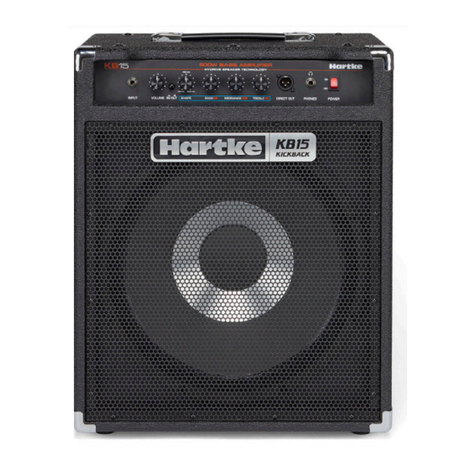
Hartke
Hartke Kickback KB12 User manual
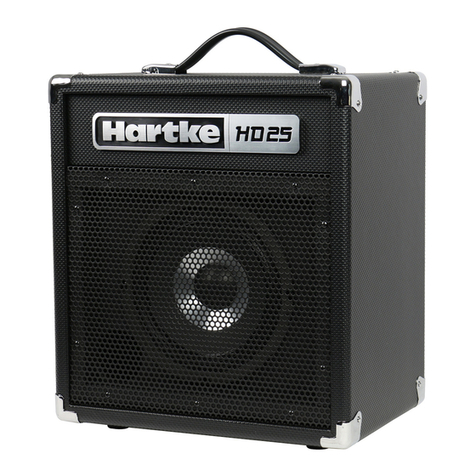
Hartke
Hartke HD 25 User manual
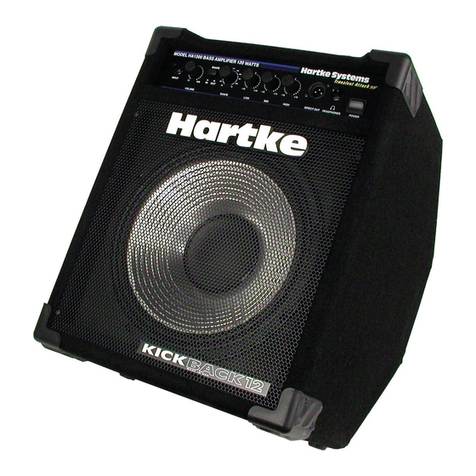
Hartke
Hartke HS 1200KickBack User manual

Hartke
Hartke HD500 User manual

Hartke
Hartke B Series User manual
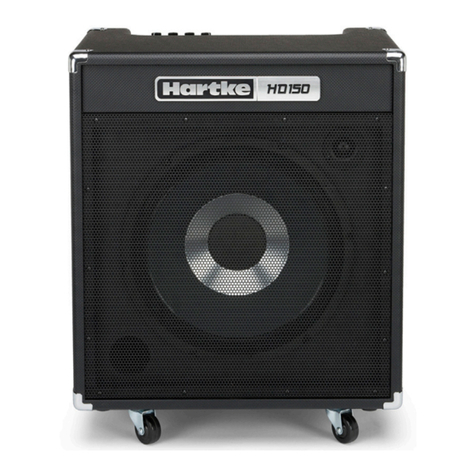
Hartke
Hartke HD 75 User manual
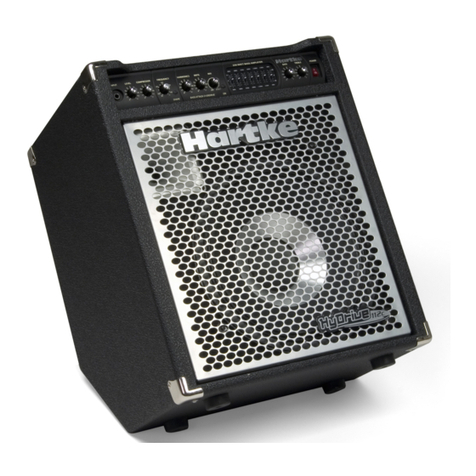
Hartke
Hartke Hydrive 112C User manual
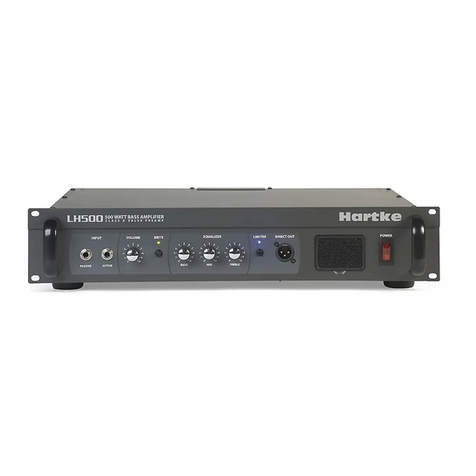
Hartke
Hartke LH500 User manual
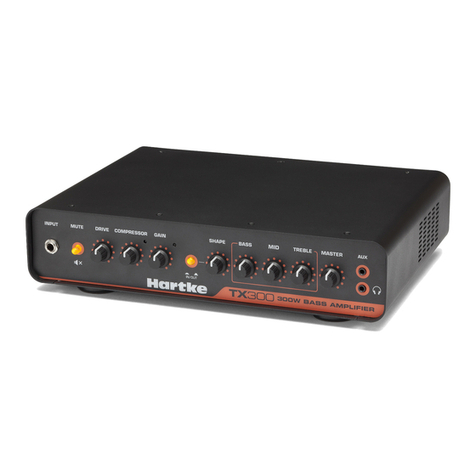
Hartke
Hartke TX300 User manual
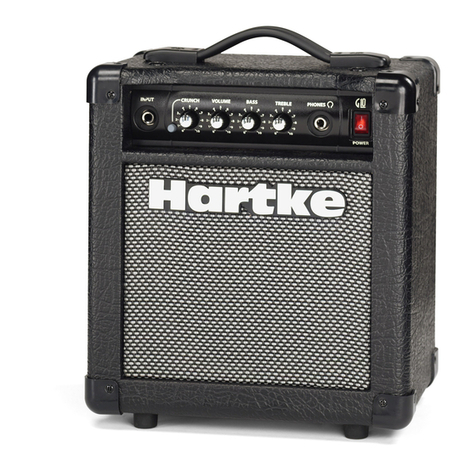
Hartke
Hartke G10 User manual
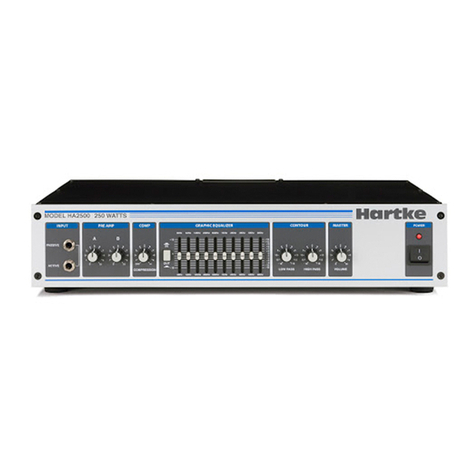
Hartke
Hartke HA2500 User manual

Hartke
Hartke HA3500 User manual
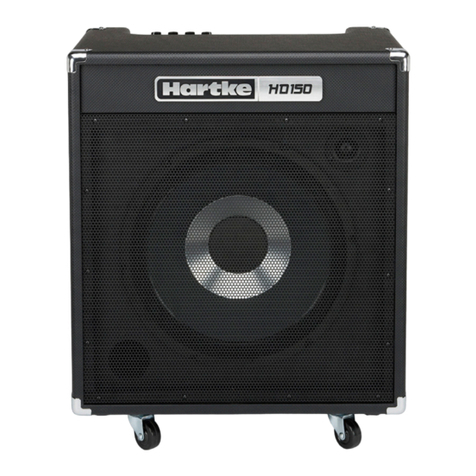
Hartke
Hartke HD 150 User manual

Hartke
Hartke VS Series User manual
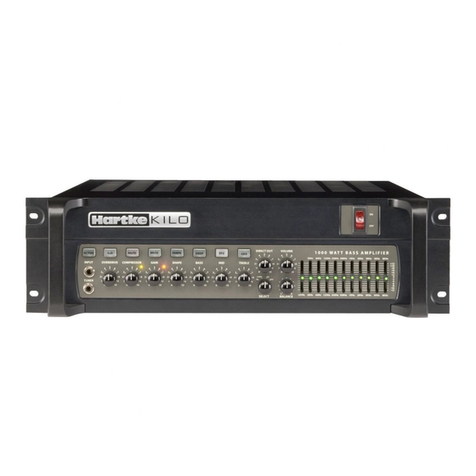
Hartke
Hartke KILO User manual
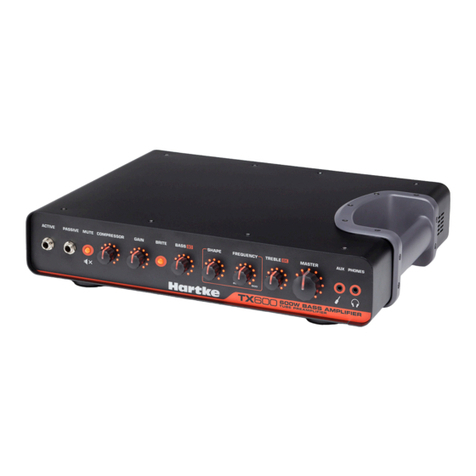
Hartke
Hartke TX600 User manual
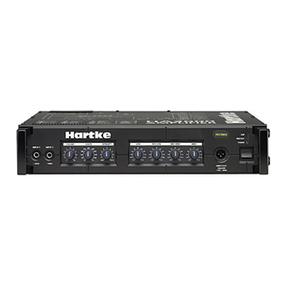
Hartke
Hartke HA4000 User manual

Hartke
Hartke 5500 User manual

Hartke
Hartke VX3500 User manual
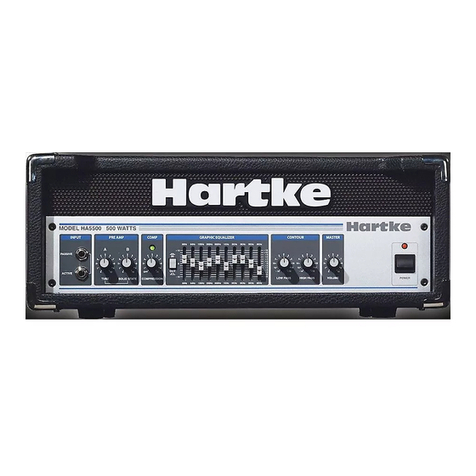
Hartke
Hartke HA5500 User manual
